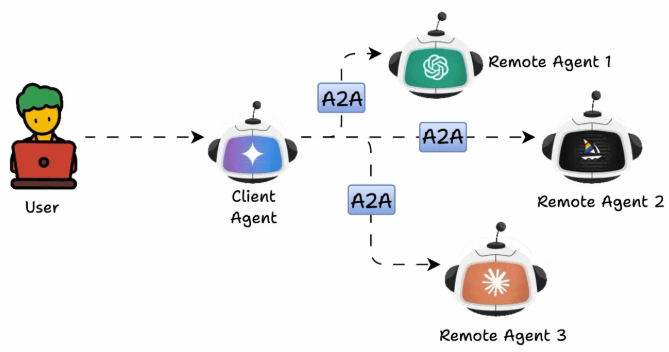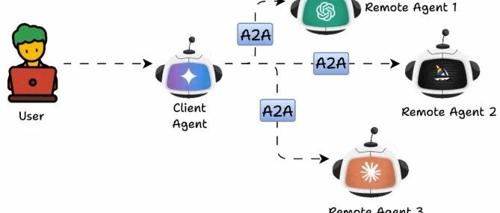“任何足够先进的技术,都与魔法无异。” —— 阿瑟·克拉克
代理到代理(A2A)协议正在彻底改变自主代理相互发现和通信的方式。A2A 并不是复杂的集成设置,而是为代理提供了一种标准化的方式来找到彼此并无缝交换信息。

今天,我们将通过从零开始构建一个天气代理系统(包括 A2A 服务器和客户端)来深入理解 A2A 协议。重点介绍 A2A 协议的核心部分——发现流程。在这个过程中,客户端通过 A2A 服务器公开的代理卡(Agent Card)来查找并理解代理的功能。
接着,我们会演练客户端如何使用 /tasks/send 端点向代理发送任务,服务器如何处理该任务,以及如何返回响应并由客户端解析和展示。
在过程中,我们还会拆解任务的结构(Task):它由消息(Message)组成,而每条消息又由若干部分(Part)构成。在这个示例中,我们保持简单,只使用 TextPart。
为了让流程清晰,我们采用一个最基础的 A2A 设置:一个服务器端代理和一个客户端。服务器代理利用大型语言模型结合 Tavily API 获取并格式化天气信息,客户端则通过标准 A2A 流程与之交互。
我们的目标不是堆砌复杂性,而是理解 A2A 协议的基本机制:发现、任务启动与响应处理。
项目设置
项目文件结构如下:
a2a-weather/├── server/│ └── weather_server.py├── client/│ └── weather_client.py├── requirements.txt└── .env
1. 创建项目环境
# 创建项目目录mkdir a2a-weathercd a2a-weather# 使用 uv 初始化环境uv init# 创建并激活虚拟环境uv venvsource .venv/bin/activate # Windows: .venv\Scripts\activate
2. 创建 requirements.txt
flask==3.0.0requests==2.31.0tavily-python>=0.3.0python-dotenv==1.0.0tiktoken>=0.7.0langchain-google-genai==1.0.10
安装依赖:
uv pip install -r requirements.txt3. 获取 API Key
-
Gemini API Key:前往 Google AI Studio,登录账户,点击「获取 API Key」,创建并复制。
-
Tavily API Key:前往 tavily.com 注册并获取(支持免费套餐)。
将两者配置到 .env 文件中:
TAVILY_API_KEY=your_tavily_api_key_hereGOOGLE_API_KEY=your_google_gemini_api_key_here
构建 A2A 天气服务器
在 server/weather_server.py 中实现服务器逻辑:
from flask import Flask, request, jsonifyfrom tavily import TavilyClientfrom langchain_google_genai import ChatGoogleGenerativeAIimport osfrom dotenv import load_dotenvload_dotenv()# Initialize Flask app, Tavily client, and Gemini LLMapp = Flask(__name__)tavily = TavilyClient(api_key=os.getenv('TAVILY_API_KEY'))llm = ChatGoogleGenerativeAI(model="gemini-2.0-flash-exp", google_api_key=os.getenv('GOOGLE_API_KEY'))def agent_card():"""A2A Discovery endpoint - tells other agents what we can do.This is the first endpoint any A2A client will call."""return jsonify({"name": "WeatherBot","description": "Get current weather information for any city using real-time data with AI-enhanced summaries","url": "http://127.0.0.1:5000","version": "1.0","capabilities": {"streaming": False,"pushNotifications": False}})def handle_task():"""Main A2A endpoint where clients send tasks.This is where the actual work happens."""try:# Get the task data from the A2A clienttask_data = request.get_json()task_id = task_data.get("id")# Extract the user's message textuser_message = task_data["message"]["parts"][0]["text"]except (KeyError, IndexError, TypeError):return jsonify({"error": "Invalid A2A task format"}), 400try:# Use Tavily to search for weather informationsearch_query = f"current weather {user_message}"search_results = tavily.search(query=search_query,search_depth="basic",max_results=3)# Combine search results for processingraw_weather_data = []for result in search_results.get('results', []):raw_weather_data.append(f"{result['title']}: {result['content']}")if raw_weather_data:# Use Gemini to create a concise, well-formatted weather summarycombined_data = "\n\n".join(raw_weather_data)prompt = f"""Based on the following weather search results, provide a concise and well-formatted weather summary for {user_message}.Raw weather data:{combined_data}Please provide:1. Current temperature and conditions2. Key weather details (humidity, wind, etc.)3. Any relevant weather alerts or notable informationKeep the response under 150 words and make it clear and easy to read."""response = llm.invoke(prompt)response_text = response.contentelse:response_text = "Sorry, I couldn't find current weather information for that location."except Exception as e:response_text = f"I encountered an error getting weather data: {str(e)}"# Return properly formatted A2A responsereturn jsonify({"id": task_id,"status": {"state": "completed"},"messages": [task_data["message"], # Echo back original message{"role": "agent","parts": [{"text": response_text}]}]})if __name__ == "__main__":print("Starting WeatherBot A2A Agent on http://127.0.0.1:5000")app.run(host="127.0.0.1", port=5000, debug=True)
这个服务器提供了:
-
Agent Card:在
/.well-known/agent.json暴露能力信息,供客户端发现。 -
任务处理:在
/tasks/send端点接收并处理任务。 -
数据获取:通过 Tavily 拉取实时天气数据。
-
智能总结:用 Gemini 将数据总结为简明天气报告。
-
标准化响应:返回符合 A2A 格式的 JSON,包含原始请求和 AI 回复。
构建客户端代理
在 client/weather_client.py 中实现客户端:
import requestsimport uuidclass WeatherClient:def __init__(self, server_url="http://127.0.0.1:5000"):self.server_url = server_urlself.agent_info = Nonedef discover_agent(self):"""Step 1: Discover the weather agent using A2A discovery flow."""discovery_url = f"{self.server_url}/.well-known/agent.json"try:response = requests.get(discovery_url)response.raise_for_status()self.agent_info = response.json()return self.agent_infoexcept requests.exceptions.RequestException as e:raise Exception(f"Could not discover agent: {str(e)}")def ask_weather(self, location):"""Step 2: Send a weather query to the agent using A2A task format."""if not self.agent_info:raise Exception("Agent not discovered. Call discover_agent() first.")# Create unique task IDtask_id = str(uuid.uuid4())# Build A2A task payloadtask_payload = {"id": task_id,"message": {"role": "user","parts": [{"text": f"weather in {location}"}]}}# Send task to servertask_url = f"{self.server_url}/tasks/send"try:response = requests.post(task_url, json=task_payload)response.raise_for_status()result = response.json()# Extract agent's response from A2A message structuremessages = result.get("messages", [])if messages and len(messages) > 1:return messages[-1]["parts"][0]["text"]else:return "No response received"except requests.exceptions.RequestException as e:raise Exception(f"Weather request failed: {str(e)}")def main():"""Demo function showing how to use the A2A weather client."""client = WeatherClient()print("A2A Weather Client Demo")print("=" * 40)try:# Step 1: Discover the weather agentprint("Discovering weather agent...")agent_info = client.discover_agent()print(f"Found: {agent_info['name']} - {agent_info['description']}")# Step 2: Ask for weather in different citiescities = ["London", "Tokyo", "New York"]for city in cities:print(f"\nGetting weather for {city}...")weather_response = client.ask_weather(city)print(f"Response:\n{weather_response}\n")print("-" * 40)except Exception as e:print(f"Error: {str(e)}")if __name__ == "__main__":main()
客户端遵循标准 A2A 流程:
-
发现代理:调用
/.well-known/agent.json获取代理信息。 -
构建任务:生成唯一 ID,并打包为标准 A2A 消息结构。
-
发送任务:POST 请求到
/tasks/send。 -
解析响应:从标准消息格式中提取代理回复。
测试
启动服务器:
cd a2a-weathersource .venv/bin/activateuv run python server/weather_server.py
另开终端运行客户端:
cd a2a-weathersource .venv/bin/activateuv run python client/weather_client.py
你将看到 Gemini 格式化后的天气摘要,结果更加清晰、易读。
A2A 协议把原本复杂的“代理间通信”问题,变成了一个简洁的标准化流程。仅仅依靠两个端点和统一的消息格式,任何 A2A 客户端都可以与任何 A2A 服务器对话,而无需自定义适配。
在本示例中,我们通过 Tavily 获取实时天气数据,再用 Gemini LLM 对数据进行智能化总结,实现了一个 具备发现、任务执行、响应处理的完整代理系统。
-
A2A 的核心价值在于“发现”和“标准化通信”,这使得代理能够像互联网中的服务一样自由组合。
-
AI 的价值在于提升交互体验,A2A 保证了“能连通”,而大模型保证了“能用好”。
-
对开发者来说,A2A 协议降低了代理生态系统的“摩擦成本”,未来任何新代理都能像“即插即用组件”一样快速接入。
一句话总结:A2A 是智能体世界的 TCP/IP,而 LLM 是它的应用层大脑。
(文:AI技术研习社)

